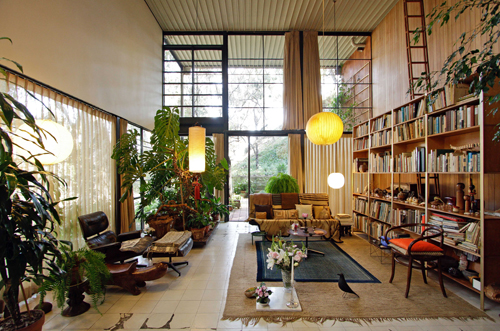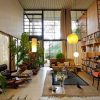
On my first academic trip to Los Angeles over ten years ago I visited the Eames House in Pacific Palisades. Frozen in time, preserved in the way Ray Eames left it upon her death in 1988, I peered through its steel framed windows to find it standing still in design and time except for one thing: the plants.
Charles and Ray may no longer breathe life on this earth, but their plants still do. The greenery is what made the rooms stay alive, filled with moisture, fresh air and change. Without them, time would have truly stood still; with the plants’ continuing presence in the place, change slowly occurs each day — its long continual metamorphosis not seen until one returns after a period of months, years. But they maintain; they live.
Lately the Eames have been the talk of the town getting credit and attention well deserved, particularly because of their inclusion in the LACMA California Modern, 1930-1965: “Living in a Modern Way” show open now until June 3 and the recent documentary Eames: The Architect and The Painter. The entire contents of their living room has been moved temporarily to LACMA for the exhibition, giving their home some much-needed downtime for preservation. All the wonderful knick knacks, the library, the rugs and furniture have been cataloged and photographed and now can be observed in a gallery, except for the plants. There are artificial replacements in the show (and I’m not sure where the plants are right now — hopefully just vacationing somewhere sunny,) but without their presence amongst the objects in the exhibit, the home now feels expired.

The greenery in the Eames house is as integral as the glass, the wood paneling, the paintings, and the objects Charles and Ray collected along side them. Without it, the home’s straight industrial lines would terminate, cross, divide in an unsettling way. Ray realized this too and so the home was filled with greenery of varying scale.

Whether in a permanent gravel bed continually filled with plants in pots or in the large dried tumbleweed collection that hung from the loft ceilings (below), the plants were likely chosen for their broad need leaves and the shadows that they made whether on the interior or on the translucent windows visible from the exterior at night.

You can view the room without the greenery via the time-lapse of the room’s de- and re-construction at LACMA. The plants were the first to leave and the last to be replaced. The room without their inclusion is barren, cold and still. The large scale of the room and the relatively small scale of its furniture seem at odds with each other. The cracked and worn tile is more noticeable. The greenery makes the difference.
So whatever way you choose to incorporate green in your home, whether it’s via ornate modernist pots, flea market finds, or via standard clay pots from your nursery (they were good enough for the Eames), the Eames have shown that it makes a home literally alive, lived-in, loved and balanced. Artificial just doesn’t do it justice.

Top photo by Ricardo DeAratanha / Los Angeles Times, all others by Tim Street-Porter, Prints and Photos Division.







